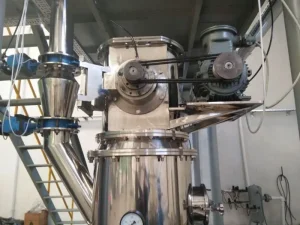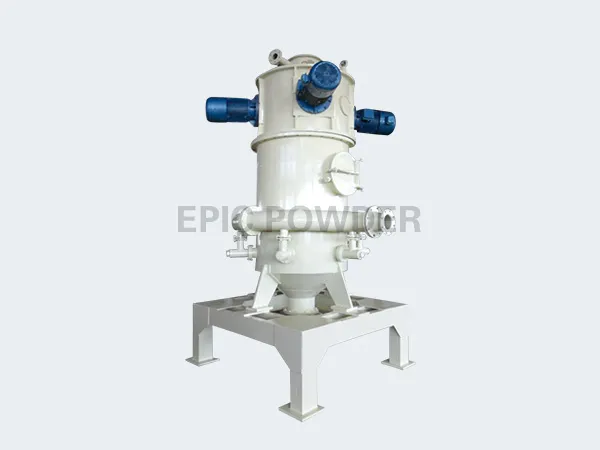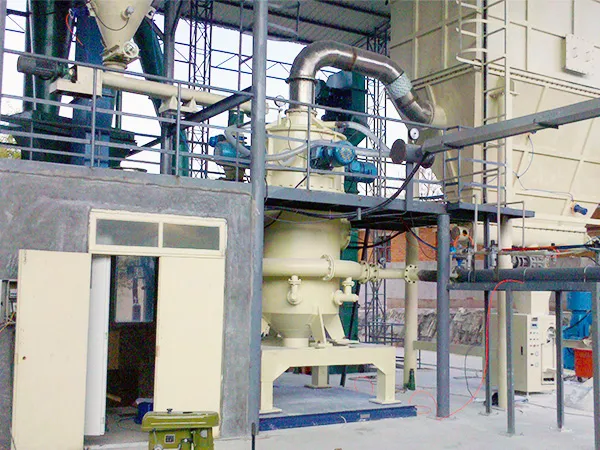
MQW jet mill is a Fluidised Bed Opposed Jet Mill, with built-in horizontal classifying wheels (single wheel or multiple wheels). After the compressed air is filtered and dried, it is sprayed into the grinding chamber through the Laval nozzle at high speed. At the intersection of multiple high-pressure airflows, the materials are repeatedly collided, rubbed, and sheared to be crushed. The ground materials rise with the suction force of the fan. The airflow moves to the classifying area, under the strong centrifugal force generated by the high-speed rotating classifying turbine, the coarse and fine materials are separated, the fine particles that meet the particle size requirements enter the cyclone separator and dust collector through the classifying wheel, and the coarse particles descend to the grinding area to continue grinding.


Fluidized Bed Opposed Air Jet Mill: After the compressed air is filtered and dried, it is sprayed into the grinding chamber at high speed through the Laval nozzle. At the intersection of multiple high-pressure airflows, the materials are repeatedly collided, rubbed, and sheared to be crushed. The crushed materials rise with the suction of the fan. The airflow moves to the classification zone. Under the action of the strong centrifugal force generated by the high-speed rotating classification turbine, the coarse and fine materials are separated. The fine particles that meet the particle size requirements enter the cyclone separator and dust collector through the classification wheel for collection, and the coarse particles descend to the crushing zone and continue to be crushed.
| parameter/ Model | MQW03 | MQW06 | MQW010 | MQW20 | MQW30 | MQW40 | MQW60 | MQW80 | MQW120 | MQW160 | MQW240 |
|---|---|---|---|---|---|---|---|---|---|---|---|
| Feeding Size(mm) | <1 | <2 | <2 | <3 | <3 | <3 | <3 | <3 | <3 | <3 | <3 |
| Production Capacity(kg/h) | 0.3~10 | 10~150 | 20~300 | 40~600 | 100~900 | 200~1200 | 500~2000 | 800~3000 | 1500~6000 | 2000~8000 | 4000~12000 |
| Particle size(D97:μm) | 3~45 | 3~45 | 3~45 | 3~45 | 3~45 | 3~45 | 3~45 | 3~45 | 3~45 | 3~45 | 3~45 |
| Classifier motor (kw) | 2.2 | 3 | 5.5/7.5 | 7.5/11 | 11/15 | 15/7.5x3 | 7.5x3 | 11x3 | 15x3 | 15x4 | 15x6 |
| Air consumption(m³/min) | 3 | 6 | 10 | 20 | 30 | 40 | 60 | 80 | 120 | 160 | 240 |
| Air pressure(Mpa) | 0.6~1 | 0.6~1 | 0.6~1 | 0.6~1 | 0.6~1 | 0.6~1 | 0.6~1 | 0.6~1 | 0.6~1 | 0.6~1 | 0.6~1 |
Note: The production capacity is closely related to the particle size, specific gravity, hardness, moisture and other indicators of the raw materials. The above is only for selection reference.
Among particle size reduction technologies, jet milling’s advantages include:
It can achieve very fine particles. It also creates tight size distributions. This is better than other milling methods.
No knives, blades, or hammers. Also, no milling media or screens. This means minimal risk of contamination from worn mill parts.
The simple chamber design is easy to clean, reducing risk of cross contamination
Grinding doesn’t cause temperature changes. This is unlike mechanical mills. Such changes are important for heat-sensitive materials.
Different materials act differently on the jet mill. The best materials are:
Abrasive
Brittle
Dense
Hard
Very friable (in other words, easy to crumble)
Jet mills also have their disadvantages, though they’re few. For one, they can be expensive to buy — which is why working with a toll processor is a smart business decision. A partnership can be a great way to get the benefits of jet milling technology and still manage costs. The process also needs high energy. It needs specialty gases and other special items to meet the specs.
Materials that may respond poorly to the jet milling process are often:
Elastic
Wet
Sticky
Light and fluffy
Easily deformed
Shock absorbent
Difficult to accelerate
Of course, a toll processor has years of experience. They have been meeting tough particle specs. They already have the gear and know-how. They can use it well to get the best results.
By working with a tolling partner’s technical team, you will gain efficiency. They will help choose the best mill type. They will also pick the right speed and feed rate. They will also cover any special project needs.
The team brings focused insights and extensive experience to the table. However, you should also expect to provide safety data sheets and answer a few questions, such as:
A jet mill is a type of ultrafine grinding equipment. It is a machine that uses a lot of energy. Therefore, the feed particle size of the air flow mill should be as fine as possible. It is recommended that the feed particle size be less than 80 mesh. Under normal circumstances, the feed particle size needs to be less than 1 mm.
Jet milling usually makes particles that are 1 to 10 microns in size. This is referred to as micronization.
Some product formulations require particles as small as 200 nanometers. The material's properties determine how small these sizes can be. You can make them smaller by increasing the mill's power. Additionally, by increasing the time the material spends in the milling chamber.
Some products require particles larger than 10 microns. This can be achieved by reducing the power to the mill or increasing the feed rate to the equipment.
In both circular and fluidized bed mills, jets of air or steam are made by gas. The gas is compressed to a gauge pressure of 50 to 120 psig. The most common gas used is commercially compressed air.
Superheated steam (392–980°F) is compressed to 100–220 psig. It can also be used on raw feed materials that are not heat-sensitive. Some of the other gases used include:
Nitrogen, which can protect materials from oxidation and/or fire
Argon, another inert option, though more expensive than nitrogen
Helium, used to achieve higher-velocity impact between particles
A great deal of energy is needed to create enough momentum to cause particles to break on impact. The compressor and nozzles turn high air pressure into energy. They do this within the mill. Large particles recirculate, and multiple high-velocity collisions progressively reduce their mass.
Jet mill is versatile and efficient. It is used widely in many industries. It uses high-pressure jets of gas or air to hit and crush materials. This makes them into fine particles. This article will explore jet mills. It will highlight their uses in diverse materials and industries. More>>
THE MACHINES WE CAN PROVIDE
CONTACT OUR TEAM
Please fill in the form below.
Our experts will contact you within 6 hours to discuss your needs for machine and processes.
© 2000-2023 Calcium Carbonate High-Value Process Expert | EPIC powder Machinery Co., Ltd. | All rights reserved | Privacy policy
Please fill in the form below.
Our experts will contact you within 6 hours to discuss your needs for machine and processes.